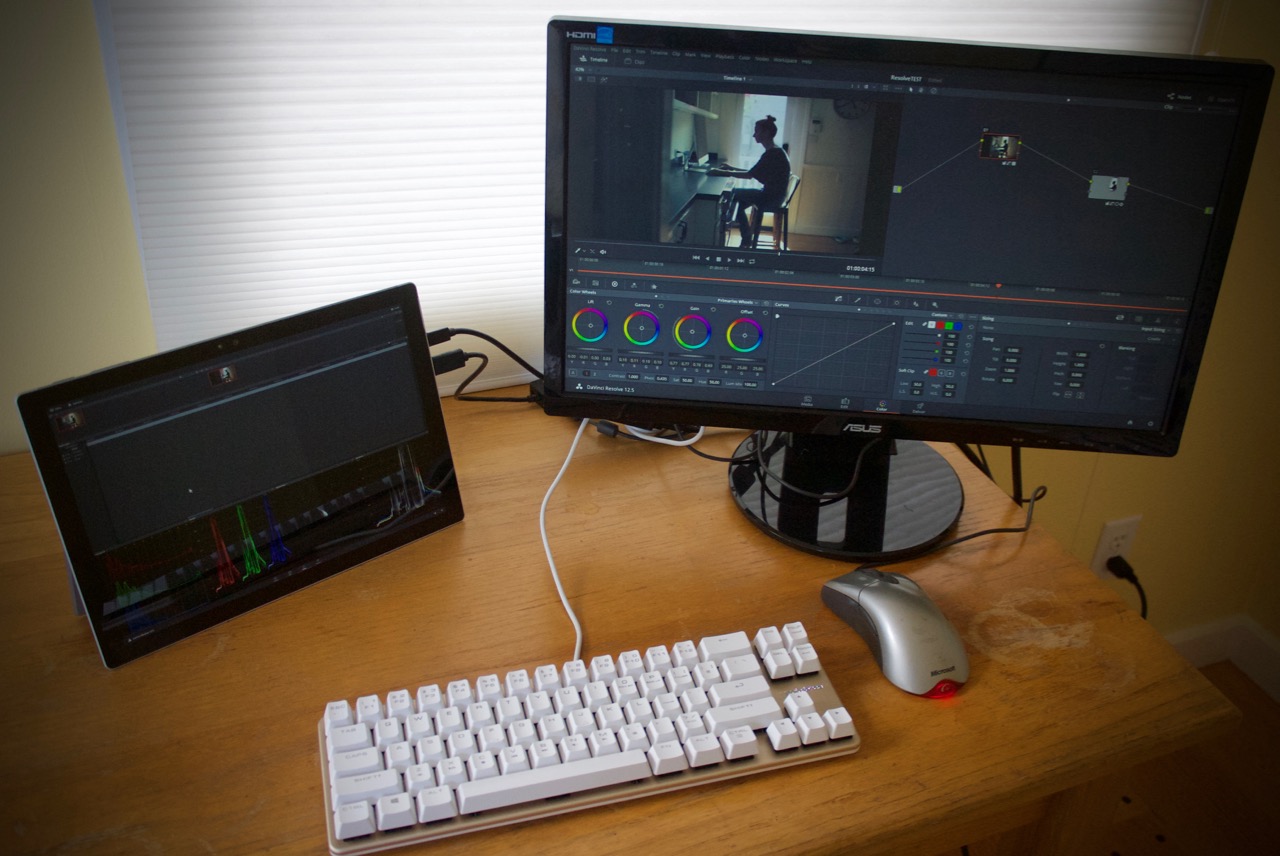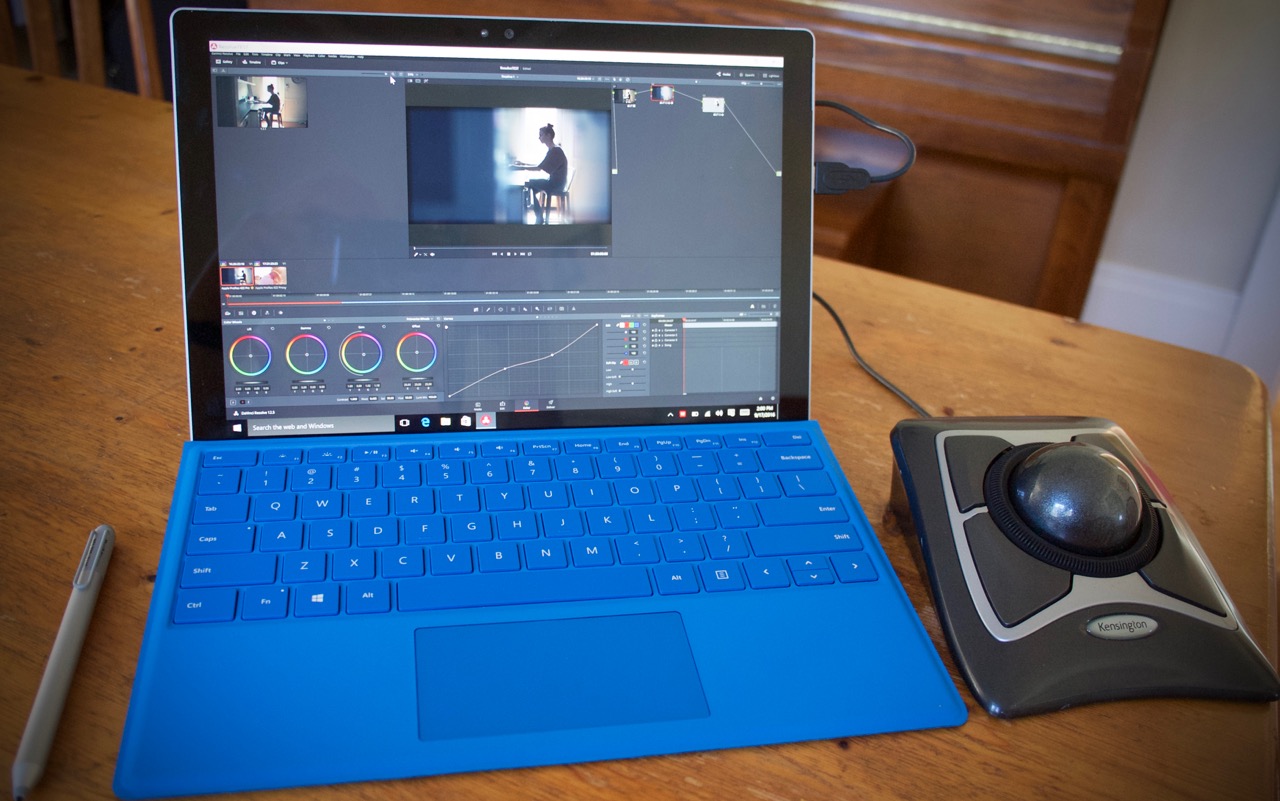Blackmagic Design and Intel loaned me a Surface Pro 4 to test the performance of the Iris GPU and Core i7 processors. I got to see exactly how close we are to a future-present where film grading can happen on machine so small you could easily lose track of it on a messy desk.

The ironic tech-prediction-punchlines from five years ago: “Wireless Photoshop”, “4k on your phone”, have all quickly come to pass. Today, I add one more punchline to the dustbin of clickbait titles: “DaVinci on a tablet”.
The unit I tested came loaded with a core i7 processor (i7-6650U @ 2.2GHZ), Intel Iris 540 GPU, 16GB of RAM, and 512GB SSD. This is the second most expensive model in the Surface Pro 4 line up, retailing at $2199 on the Microsoft Store website. This price puts it in the class of high-end laptop rather than iPad-challenger. The Surface Pro is only a tablet in the sense that it has a multi-touch screen and detachable keyboard. In price and performance one should compare it with a MacBook Pro 15” Retina (Iris GPU, 16GB Ram, Core i7 procs and 512GB SSD).
DaVinci Resolve Performance
Working with 1080P, 24 frame, ProRes footage (which works on Windows since Resolve 12.5.2), I can do three nodes without dropping frames: a LUT transformation, a primary pass and a secondary with a single mask. Anything more complicated than that, and I start working in non-realtime. This is pretty common for laptop color grading performance in my experience.
A Perfectly Tiny Screen
The Surface Pro has a 12.3 inch screen that displays 1080. The Resolve UI is not configurable and it’s designed for a much larger display area. When rendered on the screen of the Surface Pro, it’s a perfect miniature and eye-straining to use.

I could easily see using Resolve on the Surface alone, if I could just grab one or two of it’s palettes. A user could customize various set ups for asset management or basic grading tasks if only Blackmagic gave us the chance (hint, hint).
This problem is easily solved by connecting an external display and using the Surface Pro as a secondary screen and input device. Here is where my argument for customization is even more relevant. If Resolve had a customizable UI, then I could make the Surface Pro a touch-based colorociter for no extra money. Boom.
In fact, when connected to an external display, a separate keyboard and mouse, the Surface Pro 4 feels like working on a much bigger machine. Performance of the OS and applications are zippy. Using the Surface screen as an input device (both multitouch and with the stylus) is intuitive and easy. It’s really like having a couple of screens, a keyboard and no computer.
You will definitely want to keep the Surface Pro 4 plugged into AC while you do this GPU intensive work. The Core i7 and Iris GPU will drain all the electrons from the battery when you’re working in Resolve.
The Workflow
As a workflow model for grading, the Surface Pro 4 is almost perfect. I can work in my color suite with a large screen and peripherals like I’m used to. And, at the end of the work day, I can pick up the Surface Pro and walk out the door with the entire project and all my work. Also, I have all my email, Netflix, music, etc, traveling with me.
I say almost perfect because there is one crucial piece missing from this puzzle: video output. The Surface Pro 4 has a miniDisplay port and single USB3 port. As of this moment, there is no way to get a 10bit video signal out of the Surface Pro 4 because it is not certified to work with the one device that will do that, the Blackmagic UltraStudio Pro. Not being able to see what you’re color grading on a color critical display is a crucial part of the grading pipeline, and a deal breaker for colorists.
There’s piles of other work you can do: editing, asset management, LUT application, etc that don’t require this piece of the pipeline. And for those workflows, the Surface Pro 4 works just fine. But it’s not a machine you’re going to build a color grading suite around. On that point, if you’re building a Windows a grading suite, 2200 dollars will buy you serious GPU horsepower if you go with a custom desktop, rather than a portable. However, you can’t unplug that desktop machine and watch Netflix on the train home with it. There’s a trade-off between convenience and power. However, as product line-ups like the Surface gain more power, this seems less and less of a trade off.
Personally, I want all of my computers small. I want SSDs in everything and an end to the era of back-straining color grading monster towers. As GPUs continue to evolve, I can see that in a year or two, there could be a machine like the Surface Pro that will offer lots of power with few compromises. Hopefully by then, the Resolve UI will offer customization options that take into account the new workflow of grading-on-the-go set ups.
Bottomline
Resolve on the Surface Pro 4 is a proof-of-concept, not a workflow I’d recommend to anyone looking for a machine to do serious color grading on.
Think of Resolve as a benchmark for just how far tiny computers have come in terms of capability, and a marker for where they are going. This is a beast of a miniature machine, as powerful as many computers that are in use in existing post production work environments that are just a few years older.
And while you can color grade in Resolve 12.5 on the Surface Pro 4, lack of video output makes it a device best suited for editing, asset management and non color critical tasks.

